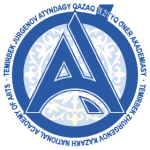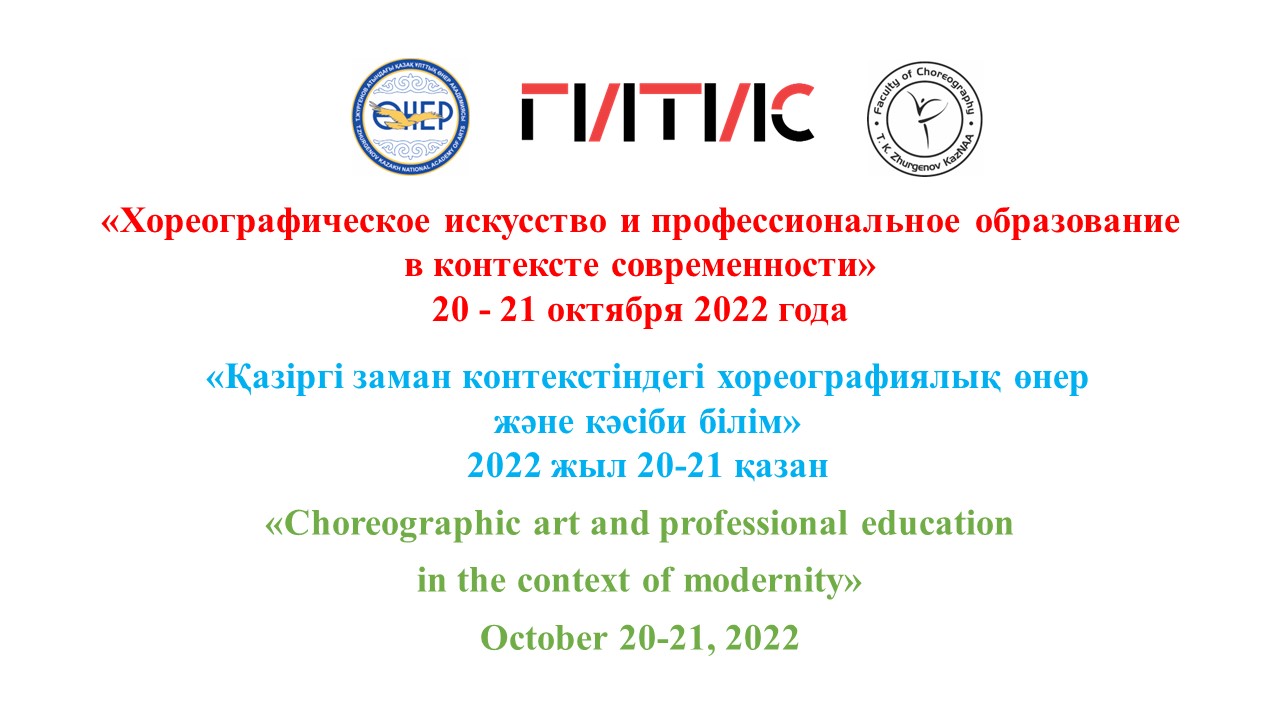Informational letter
Dear friends and colleagues!
We invite you to participate in a joint project of Kazakh National Academy of Arts named after T.K.Zhurgenov and the Russian Institute of Theatre Arts (GITIS): International scientific and practical conference “Choreographic art and professional education in the context of modernity” which takes place 20-21ST October 2022.
The guidelines of the conference:
- Higher and secondary special choreographic education in world space.
- Development and preservation of the world choreographic art traditions in various genres and directions.
- Innovations and perspectives in choreography.
- National choreographic art.
- Questions of criticism and ballet studies in choreographic art.
- Problems of repertoire policy in modern musical theatre.
- Integration of choreographic education into the world artistic culture.
- Art and choreography.
We look forward to welcoming ballet dancers, theatre critics, musicologists, art critics, scientists, choreographers, ballet teachers, university and institute professors, museum specialists, undergraduates, doctoral students, graduate students engaged in scientific and methological research activities in the field of history, art theory and art criticism. Students of higher educational institution are also allowed to take part in the work of the conference as listeners.
Within the framework of the conference there are plans for having scientific reports of scientists and artists as well as holding of seminars, master classes, concerts of faculties, performances, creative meetings and round tables.
In addition, it is planned to publish materials on the results of the conference. The collection of materials is assigned a library index (UDC and LBC) and an international standard book number (ISBN). The collection is planned to be included in the RSCI database.
The conference organizers reserve the right not to accept the submitted materials for publication in the Collection of materials based on the results of the conference.
Conference format: online/offline
Participation in the conference is allowed in the following forms:
- full-time / offline: presentation with an oral report, participation in the discussion of reports, discussions;
- correspondence: publication of a scientific article.
On the second day, in the frame of the conference, the organizers plan to conduct practicfal master classes in various areas of choreographic art and education. It will be held offline as well as online on the VC ZOOM platform.
Applications and articles are submitted to the editorial office until 10th October, 2022 at kaznai_ballet@mail.ru with the obligatory indication of the subject of the letter: KAZNAI CONFERENCE – GITIS – 2022”.
See the Appendix 1. Article Requirements and Appendix 2. Application form.
The time limit for presentations is up to 10 minutes (+5 minutes of discussion)
Official languages of the conference: Kazakh, Russian, English.
Official hashtag of the event #KazNAI-GITIS-Conference
Conference venue: Republic of Kazakhstan, Almaty, st. Panfilova, 127, Kazakh National Academy of Arts named after T. Zhurgenova, educational theatre, cinema hall, classroom complex of the faculty of choreography / Russia, Moscow, Russian Institute of Theatre Arts, Maly Kislovsky per., 6. For online participation the link is on the official website of GITIS https://gitis.het/.
Three days before the start of the conference, the Program of Events and the Schedule of the Conference will be sent out in accordance with the applications received.
Organizing committee address:
Russian Institute of Theatre Arts (GITIS): 125009, Russia, Moscow, Maly Kislovsky per., 6, Department of choreography.
The contact persons: +7 (903) 792 94 65 (Valukin Maksim Evgenievich) and +7 (916) 113 37 86 (Smeliakova Viktoria Aleksandrovna)
Official site: https://gitis.net/
Kazakh National Academy of Arts names after T. Zhurgenova: 050000, Republic of Kazakhstan, Almaty, st. Panfilova, 127, Department of choreography.
The contact person: +7 (701) 298 5554 (Sushkov Dmitriy Valentinovich)
WhatsApp, Telegram
Official site: http://www.kaznai.kz/
Appendix 1. Requirements for articles
The editors accept only original, previously unpublished scientific articles prepared in accordance with generally accepted scientific and ethical standards. Article subject must comply to the conference theme, one of the general categories or sections.
ARTICLES WHICH DO NOT CONSIDER THE ABOVE REQUIREMENTS ARE NOT ACCEPTED FOR PUBLICATION
The editors of the journal are provided with:
The author’s original text in electronic format in the Microsoft Word extension (Example of the title of the article: Ivanov_Article).
- Font: Times New Roman
- Font size: 14 pt
- Line spacing: 1.0 (no spacing between paragraphs of the same style).
- Article volume: 3-5 pages A4
1) Text structure:
1. Indexes UDC and SCSTI, revealing the thematic content of the article (in the upper part left corner in bold).
2. Information about the author / authors (in the upper right corner in italics) – full name (in full), academic degree, academic title, honorary title, position, place of work (study), including department (if any), ORCID, SPIN code, E-mail address.
Undergradutes, graduate students, doctoral students indicate all the data of the supervisor and attach scanned copied of the review of the supervisor with a certified signature and the seal of the organization where the supervisor works in JPEG or PDF format.
3. Title of the article (bold in UPPER case, centered)
4. Abstract: s summary of the article according to the following structure:
relevance of the problem and novelty, main content aspects, research methods, results. Volume: 50-100 words. Placed with a space after the title of the article. Alignment of the main text in width.
5. Key words according to the content of the abstract and article (5-8 words). Placed after the annotation. Alignment of the main text in width.
6. The main text of the article should preferably be divided into subsections (introduction, literature review, main part, research results). Alignment of the main text to the width.
7. List of sources/literature. Text alignment by width. If the article is in Russian, all the output data of the article are additionally translated (information about the author/authors, academic degree, academic title, place of work/study, including the department, ORCID, SPIN-code, email address, article title, summary, keywords (in the same volume and order as in Russian text) into English and Kazakh (for foreign authors only into English).
If the article is in Kazakh, all output data are translated into Russian and English. If the article is in English, all output data are translated into Kazakh and Russian.
Initials in the text are typed through INDISSOLUBLE SPACE with the surname (simultaneous pressing of the keys «Ctrl» + «Shift » + «space »).
The quotation marks «…» are used in the text. If there are internal and external quotation marks, then the «Christmas trees» are external, the «paws» are internal -«…”…”».
The text may use a long dash (—), obtained by simultaneous pressing the keys «Ctrl» + «Alt»+«—» (on the numeric keypad), as well as a hyphen (-).
The automatic numbering of the text editor is not used in lists. Infographics, including tables, diagrams, figures and formulas in the text should be numbered; diagrams and tables should have headings placed above the diagram or table field, and each figure should have a caption.
The list of sources (from 5 to 10 titles) is drawn up in the form of non-text bibliographic references in accordance with the accepted Gosstandart, is placed at the end of the article. The city of the publication is spelled out in full, including Moscow, Saint-Petersburg, etc.
Some examples:
Books:
Sats N.I. Children come to the theater.-Moscow: Iskusstvo, 1961.-312 p. Magazines, newspapers:
Smetova, A.A., Mukasheva, A.B. Formation and development of conducting and choral education in Kazakhstan // Buletin of KazNU. The series «Pedagogical sciences».-2015.-№1(44). – pp.4-10.
Collection of articles and conferences:
Marchenkova A.,Marchenkov A. Artistic image in choreographic art // Actual tasks of pedagogy: materials of the lll International Scientific Conference. – Chita: Young Scientist, 2013. – pp.25-32.
Electronic resources:
Podkorytova M.O. Behind the scene of Cirque Eloise. How to create a show about love [Electronic resource] // Official website of the online publication Uralweb.ru/URL: http://www.uralweb.ru/pages/provereno/6462.html (Accessed:19.04.17).
Sources are given in the order of mention/citation in the article.References to the list in the main text are given in square brackets [ source number in the list,page] (for example,[8,p.10-15;9,p.128]).
If it is necessary to recite the source, the reference is given to the number of the first mention of the source.Repeated and complex references are not used.The titles (and journal titles) in the second and subsequent references cannot be replaced by their verbal equivalents «His», «He», «There», etc.
When making a list of sources,automatic numbering of the text editor is not used, the ordinal number is separated from the reference text by the tab sign.The «dot» and «dash» signs separating the areas of the biographic description are replaced by a dot. All bibliographic references to electronic resources must indicate the date of appeal. Appeal to scientific, special or fiction literature-preferably in a printed form.
When quoting Internet resources, it is necessary to indicate as fully as possible the full name of the author (s), the exact title of the work, the name of the resource that published the described document, as well as the exact reference to the original web page (and not to the main page of the site from which the material was taken), the date of appeal, etc.
Any mention in the text of the article of the names of scientists and researchers should be accompanied by reference to their work.
The notes are made out in the form of a footnote. The footnote sign is placed immediately after the word, number, symbol, sentence to which an explanation is given. The file names in the list must correspond to the names/numbers of the photo materials provided.
2) Illustrative materials.
They are provided in electronic form as separate files through the electronic editorial system as additional materials in TIFF/JPG formats with a resolution of at least 300 dpi simultaneously with the author’s original article. It is not allowed to provide illustrations imported into Microsoft Word,as well as their photocopies.
Tables, diagrams and graphs are provided in a file in Microsoft Word or Microsoft Excel format, including the source data, in which it is possible to edit graphic materials.
Illustrative material and info-graphic should be adapted for high-quality black-and-white printing.
The author provides captions for all images (included in the file with the author’s text).
The authors of the articles are responsible for the content of the articles and for the fact of their publication.The editorial board does not always share the opinions of the authors and is not responsible for unreliability of the published data.The editorial board does not bear any responsibility to the authors and or third parties and organizations for possible damage caused by the publication of the article.
Appendix 2. Application form.
Join project
Kazakh National Academy of Arts named after T.K.Zhurgenov and Russian Institute of Theatre Arts (GITIS) Application for participation in the international scientific and practical conference «Choreographic art and professional education in the context of modernity»
October 20-21, 2022
| Last name, first name, patronymic (in full) | |
| Place of work (full name of the institution without abbreviations) | |
| Post | |
| Academic degree, academic title, honorary title | |
| Contact phone numbers (WhatsApp, Telegram) | |
| Postal address (with zip code) | |
| Form of participation in the conference (full-time/part-time) | |
| Topic of the report or article (without quotes) | |
| Presentation (yes/no) |

